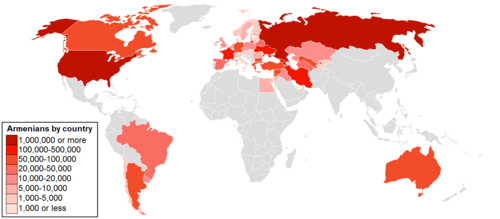| History of Armenia |
|---|
 |
| Timeline • Origins • Etymology |
The repatriation of Armenians refers to the act of returning of ethnic Armenians to Armenia.
Contents
- Background
- Origins of the Armenian people
- Foreign rule
- Displacements and deportations
- Russian Armenia (1828–1917)
- Background 2
- Armenian Oblast (1828–1840)
- Armenian refugees from the Ottoman Empire
- First Republic of Armenia (1918–1920)
- Armenian Soviet Socialist Republic (1920–1991)
- Egypt
- Lebanon
- Republic of Armenia (1991–present)
- Acquisition of an Armenian citizenship
- Syrian Civil War (2011–2024)
- 2018 Velvet Revolution
- Diaspora and NGOs (1915–present)
- See also
- References
- External links
Armenians were persecuted, forcefully displaced, and deported multiple times in their history during foreign rule. For over a thousand years, [1] the Armenian people were continuously expelled from their homeland in a process which began with the Byzantines, [2] continued with the Great Surgun under the Persian Empire, [3] and culminated in the genocide of 1915 under the Ottoman Empire.
The attachment of the Armenian people to their homeland has been sustained within the diaspora through the formation of Armenian communities and schools. Repatriation to Armenia has long been a central aspiration of the diaspora; [4] however, apart from the forced relocation of Armenians from the Middle East [5] [6] and Azerbaijan [7] [8] large-scale repatriation to Armenia has remained minimal. [9]
The goal of repatriation has faced numerous goals which have disincentivized migration. Among them are anti-Armenian sentiment within the sections of Armenian homeland that lie in Turkey (Western Armenia) and Azerbaijan, Eastern Armenia’s incorporation into the Soviet Union in 1920, the instability following its independence from the Soviet Union in 1991, the ongoing conflict with Azerbaijan since 1988, and Armenia's geographic position between two hostile neighbors—Turkey and Azerbaijan. These factors have discouraged many in the diaspora from relocating to Armenia, prompting successive generations to remain in more stable host countries. Over time, this has led to growing assimilation and, particularly among younger Armenians, a waning connection to their heritage—a phenomenon often referred to within the community as " White Genocide." [10]



